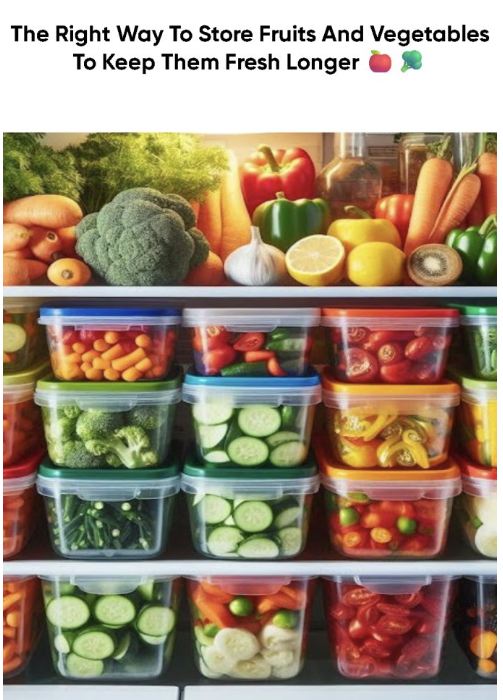ADVERTISEMENT
🧊 Fridge or Counter? Here’s Where Each Belongs
✅ Store These in the Fridge
These fruits and veggies last longer in cool, humid conditions:
- Leafy greens (spinach, lettuce, kale): Keep in a breathable bag or wrapped in a damp paper towel inside a container.
- Berries: Keep dry and in their original container or a paper towel-lined container. Don’t wash until ready to eat.
- Carrots & celery: Store in water in a sealed container or bag for extra crunch.
- Broccoli & cauliflower: Keep in a perforated bag in the crisper drawer.
- Apples: Store in the fridge to stay crisp longer.
- Grapes & cherries: Keep unwashed in a breathable bag.
🍌 Store These at Room Temperature
These do better in a cool, dry place away from sunlight:
- Bananas: Fridge turns them black (though still edible). Store at room temp.
- Tomatoes: Fridge ruins their flavor and texture. Keep on the counter.
- Onions & garlic: Store in a dry, ventilated space — not in plastic bags.
- Potatoes & sweet potatoes: Cool, dark, and dry is ideal — avoid the fridge, which alters their starches.
- Citrus fruits (oranges, lemons, limes): Can stay on the counter for a week or so, or longer in the fridge.
🚫 Fruits and Veggies That Shouldn’t Be Stored Together
🍎 Ethylene-producing fruits:
- Apples
- Bananas
- Avocados
- Tomatoes
- Peaches
- Pears
🥬 Ethylene-sensitive vegetables:
- Leafy greens
- Broccoli
- Carrots
- Cucumbers
- Peppers
Tip: Keep ethylene-producing fruits away from ethylene-sensitive vegetables to avoid early spoilage.
🥗 Pro Tips to Extend Freshness
- Use breathable storage bags or containers: Especially for leafy greens — plastic traps moisture and causes slime.
- Wrap herbs in a damp paper towel and store them in a sealed container or jar.
- Revive wilted greens by soaking them in cold water for 10–15 minutes.
- Don’t wash produce until you’re ready to eat it (except leafy greens, which can be prepped and dried properly).
- Freeze overripe produce (bananas, berries, spinach) for smoothies or cooking.
🧺 Organize Your Fridge Like a Pro
- Top shelves: Ready-to-eat foods like berries, herbs, leftovers.
- Middle shelves: Dairy, eggs, cut fruits and veggies.
- Bottom drawers (crisper): High humidity drawer for leafy greens; low humidity for fruits.
Label your drawers if needed — it helps everyone in the house store things properly!
🌿 Final Thought
Storing your fruits and vegetables the right way doesn’t just reduce food waste — it also saves money and keeps your meals tasting fresher and healthier. With just a few smart habits and a little produce knowledge, you can say goodbye to soggy lettuce and mushy strawberries for good!
ADVERTISEMENT
